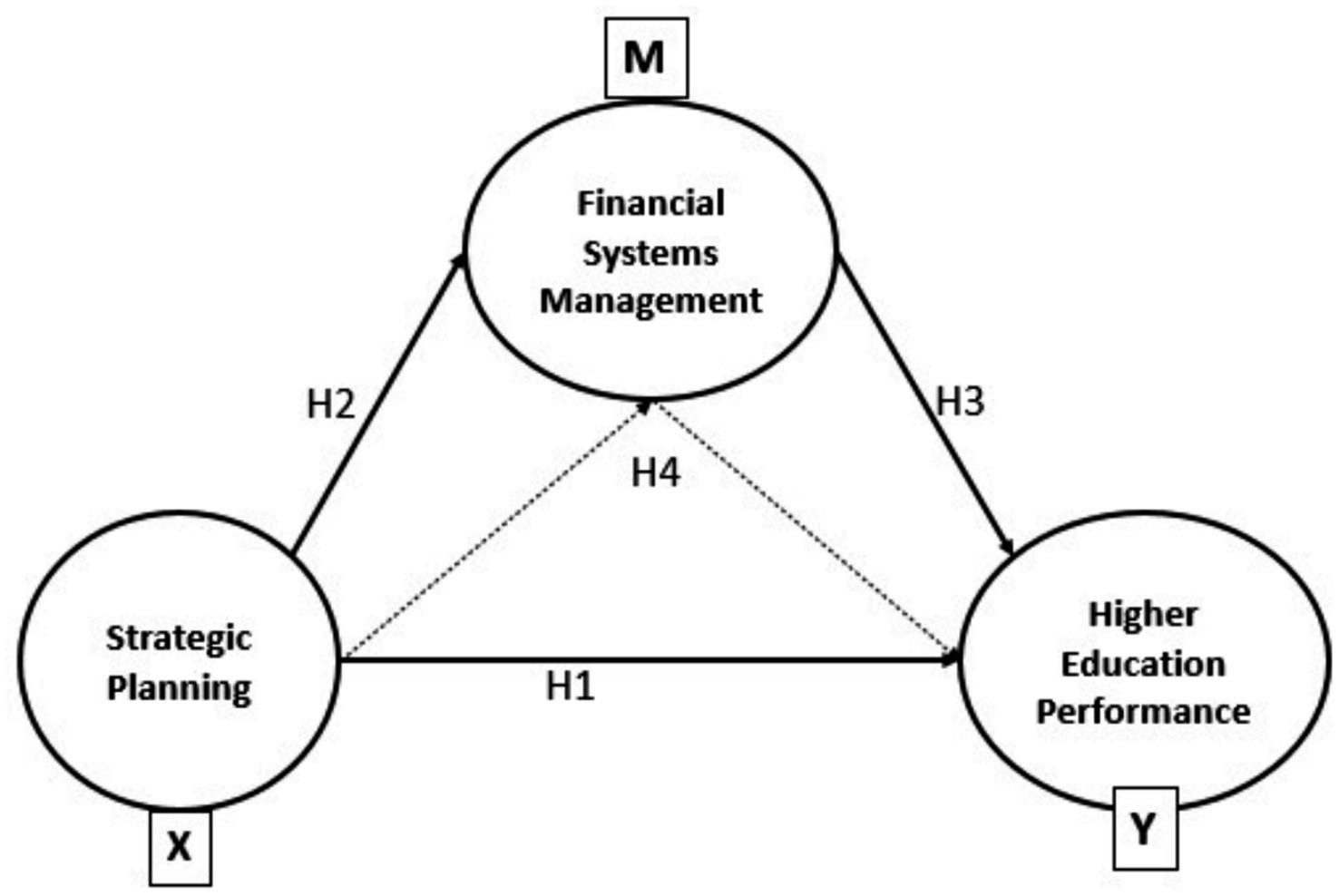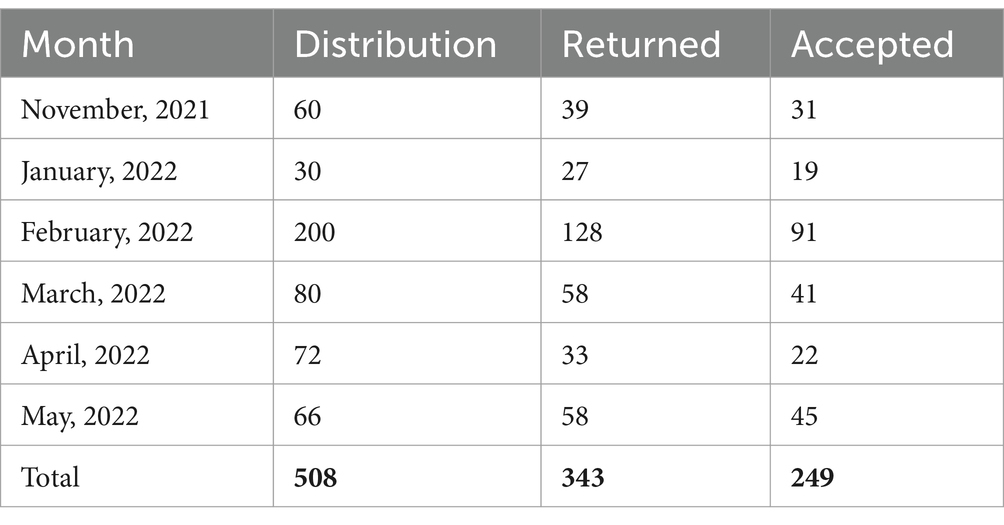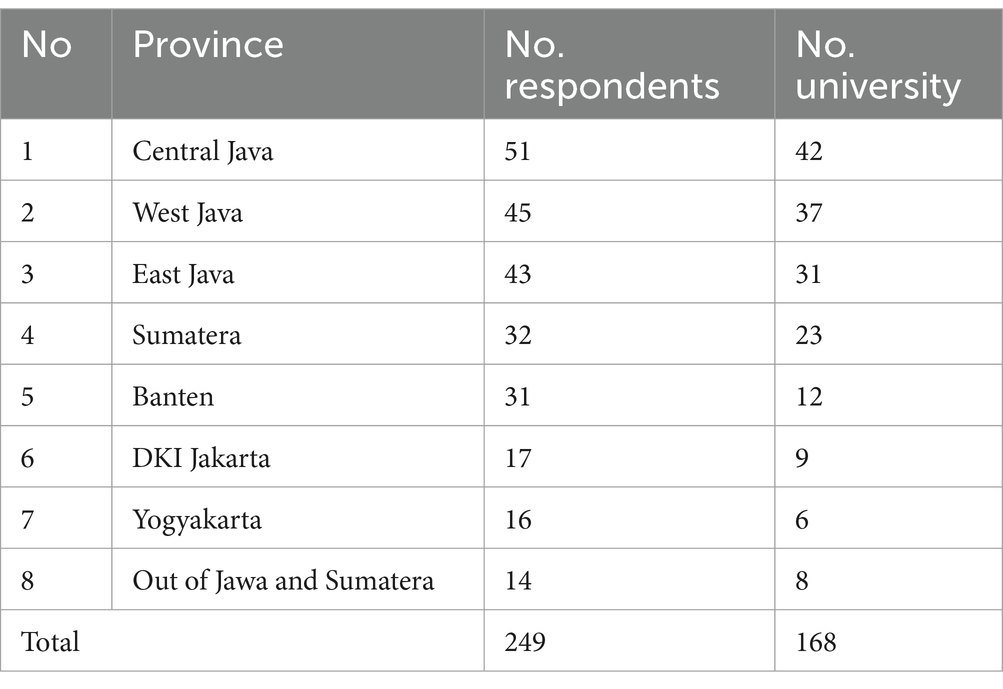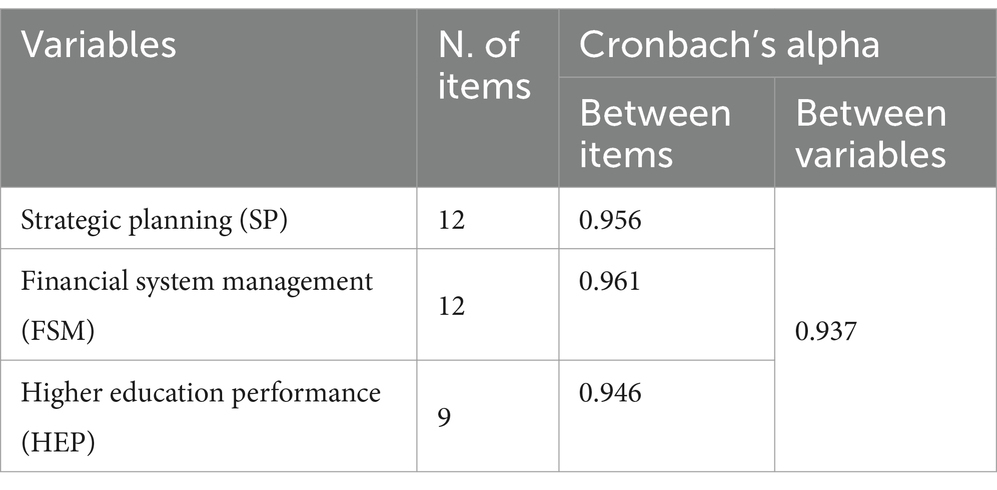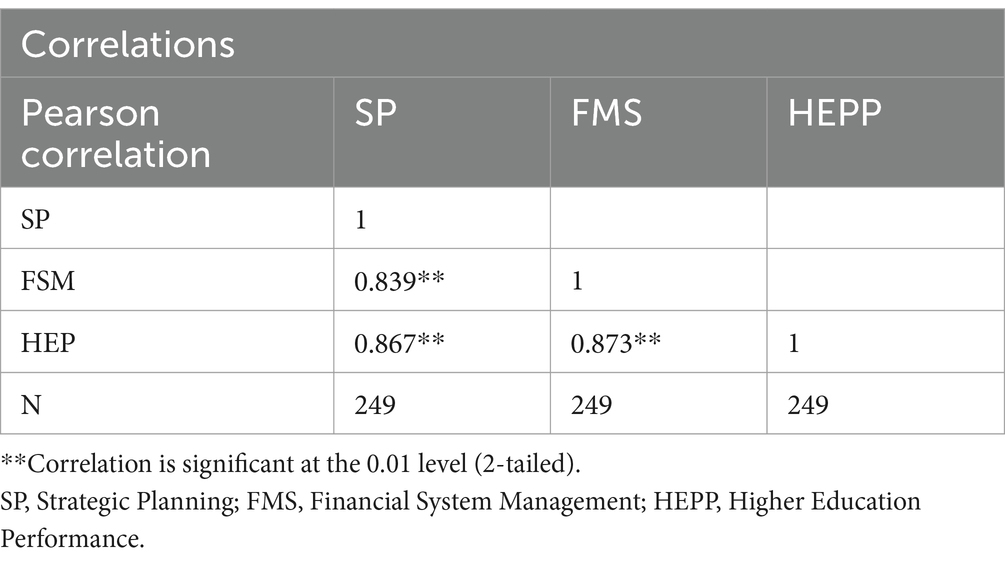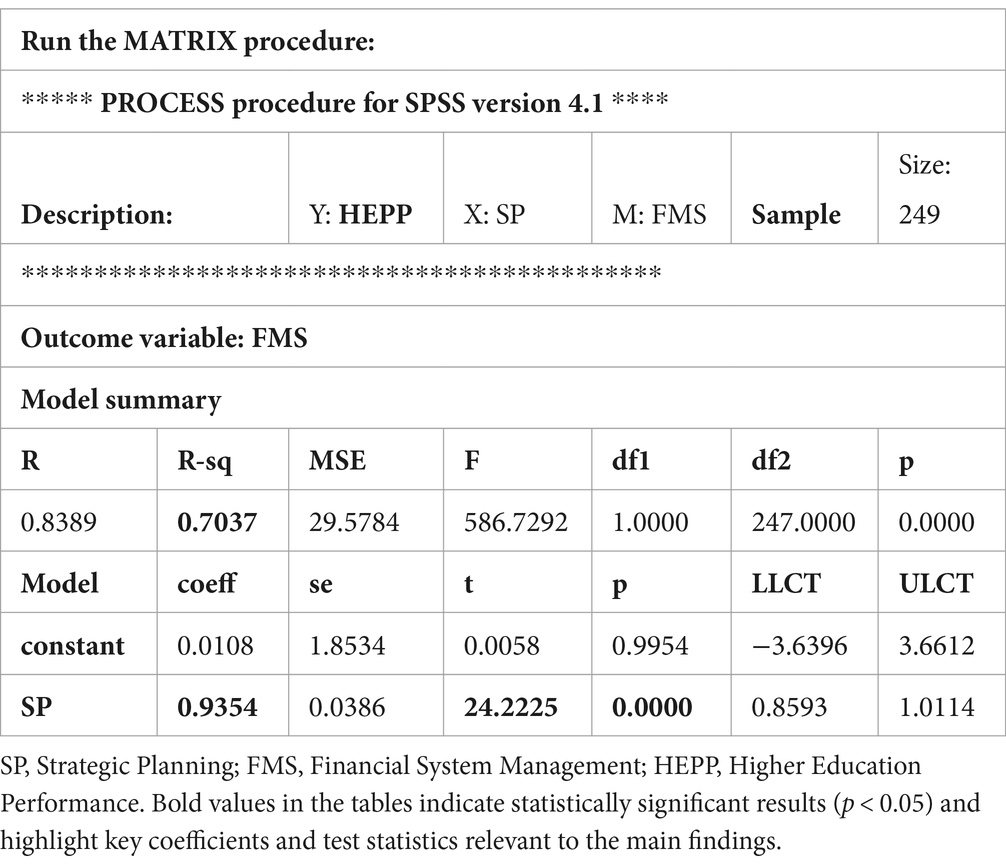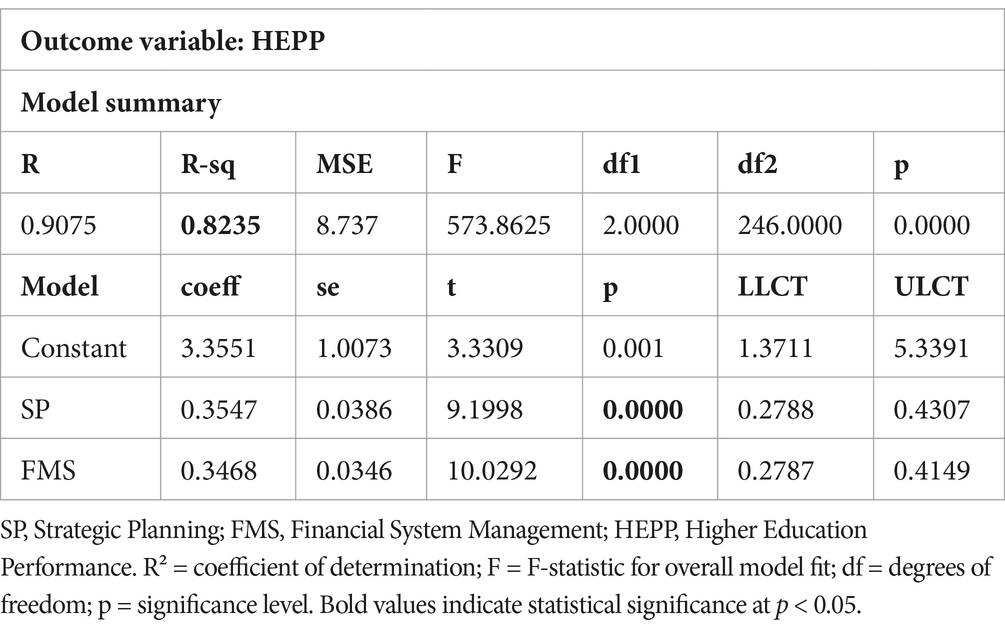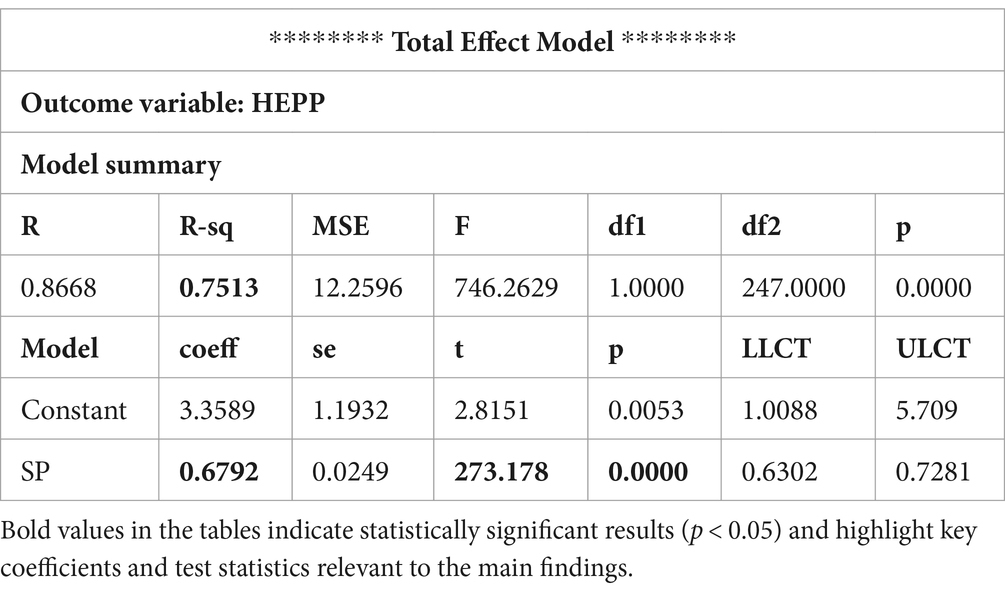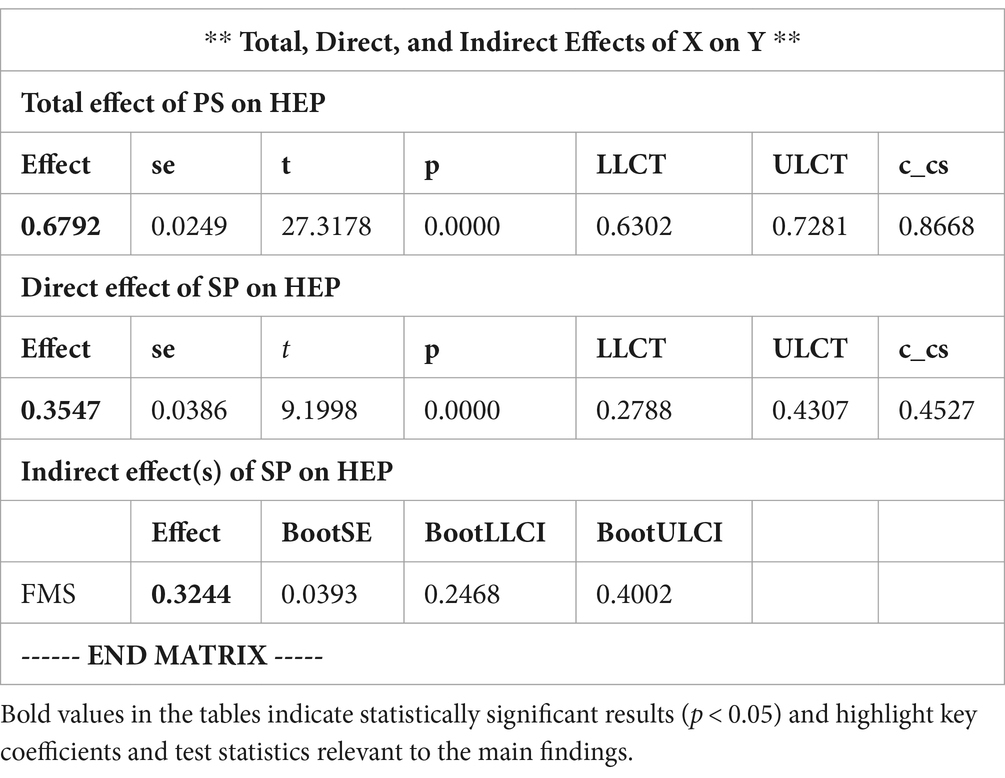- 1Faculty Economics and Business, Universitas Muhammadiyah Yogyakarta, Yogyakarta, Indonesia
- 2Doctoral Management Program, Postgraduate Studies, Universitas Muhammadiyah Yogyakarta, Yogyakarta, Indonesia
- 3University Muhammadiyah Yogyakarta, Yogyakarta, Indonesia
- 4Administrative Science Department, College of Administrative and Financial Science, Gulf University, Sanad, Bahrain
- 5Accounting and Financial Science Department, College of Administrative and Financial Science, Gulf University, Sanad, Bahrain
- 6Dubai Business School, University of Dubai, Dubai, United Arab Emirates
- 7Royal University for Women, Riffa, Bahrain
Purpose: This study aims to experimentally evaluate the effects of strategic planning and financial system management on the performance of higher education institutions. Additionally, it examines how financial system management mediates the relationship between strategic planning and organizational performance in higher education (HE).
Design/methodology/approach: This study adopts a quantitative approach. Offline and online questionnaires were distributed to academic staff at private universities in Indonesia to gather data for hypothesis testing. The SPSS macro was used to analyze responses from 249 participants and assess the proposed associations.
Findings: The findings indicate that strategic planning and financial system management have a direct impact on institutional performance. Strategic planning exerts a significant and positive influence on financial system management. Furthermore, financial system management serves as a significant mediating variable in the relationship between strategic planning and organizational performance.
Practical implications: To effectively implement quality management in higher education, administrators must recognize the distinct roles of strategic planning and financial system management in improving organizational performance. To achieve optimal performance, higher education institutions must allocate resources to establish robust strategic planning and financial management practices.
Originality/value: Although numerous studies have explored the relationship between strategic planning and organizational performance in higher education, research on financial system management in this context remains limited. This study is among the first to adopt a multidimensional approach to both strategic planning and financial system management in higher education, providing insights into their interdependence and practical significance for institutional leaders.
1 Introduction
Higher education institutions have evolved into multifunctional entities that are closely connected to their social and economic environments. They strive to enhance their vitality, efficiency, and effectiveness while upholding high-performance standards. Furthermore, they aim to fulfill their educational and social responsibilities (Arroyo, 2017; Chatterton and Goddard, 2000). Research and development (R&D) activities conducted by higher education institutions play a key role in national development, particularly in countries aspiring toward development and progress (Gibbons, 1998; Leal Filho et al., 2018). This requires close collaboration between higher education institutions and various societal sectors to assess scientific and technical capabilities. Equally important is identifying the needs of different sectors of society—particularly productive industries—to establish clear research pathways that support societal advancement. Such coordination also enables the alignment of efforts to achieve shared goals that benefit all stakeholders (Johnson et al., 2016; Suleman, 2018).
The components of organizational performance, in this context, evolve over time. The criteria used to evaluate performance, whether internal to the institution or influenced by external factors, continue to evolve. The elements determining an organization’s success in the first stage of market entry—launch—may not be applicable for evaluating its performance as it grows or matures (Grigoroudis et al., 2012). Furthermore, a specific combination of human, technical, financial, and organizational factors may result in excellent performance in one context but not in another. This is due to the numerous combinations of variables, which also evolve over time. Therefore, a key challenge for administrative leaders is identifying the optimal balance of factors to achieve high performance (Gumusluoğlu et al., 2009). As a result, organizational performance can be understood as the cumulative outcome of all institutional activities. It reflects how the institution allocates and utilizes its resources to meet its objectives (Li et al., 2006; Langley et al., 2009).
Organizational performance can be split into two categories based on the comprehensiveness criterion: The first is overall performance, which is expressed in the accomplishments that all of the organization’s functions and subsystems have contributed to without being solely a part or component of a unit in attaining them. It is possible to measure the level of the organization’s achievement and achievement of its broad goals, such as continuity, expansion, and profitability, by looking at its overall performance (Johnson, 2001; Richard et al., 2009). The second portion is partial performance, which refers to the results accomplished at the level of the organization’s subsystems and basic functions, as each subsystem strives to meet its own goals. The organization’s overall performance is attained by obtaining the total performance of the subsystems. This process enables the institution to understand its capabilities to achieve its objectives and ensures that its final product reflects its image, environment, and future (Williams, 1941; Gupta, 2005).
Recently, during the coronavirus pandemic, many institutions and companies worldwide entered into financial and administrative crises (Garad et al., 2021). However, higher education institutions were the most agitated. They suffered from many problems, including the cessation of traditional education, the transition to distance education, and the difficulty of managing and rationalizing their financial and material resources so that they can continue to fulfill their societal mission in education. Even some universities could not fully pay the salaries of their teaching and administrative staff. According to the chancellor of the Jakarta Islamic University (UID) and the secretary general of the Association of Indonesian Private Universities (APTISI), with the COVID-19 pandemic beginning to affect the Indonesian economy from mid-2020 onward, private universities have experienced a sharp downturn in enrollments, and the number of university dropouts is rising. This is causing a crisis in Indonesia’s private university sector, which some fear could lead to mass closures of institutions (Yamin, 2021).
On the other hand, strategic planning is one of the initial processes and tasks in strategic management. It has to do with deciding the organization’s future orientation, which entails defining the organization’s mission and objectives based on examining the existing and future condition of each of the surrounding environments, as well as its capabilities. The organization then transforms these objectives into strategic programs and plans. The most important sort of planning is strategic financial planning. Financial planning, on the other hand, aids in the forecasting of financial demands well in advance of the actual need for funds, as well as the evaluation and comparison of potential investment alternatives. As can be seen, financial planning is concerned with assessing the demand for finances, determining the sources from which funds may be obtained, and working to provide these monies in a timely and cost-effective manner (Bernanke et al., 1996; Blackwell, 2011). As a result, the university administration was tasked with diversifying and expanding these resources. The second point to consider is the importance of proper resource utilization and employment, which entails carrying out all university activities at the lowest feasible cost while offering services that match specified criteria (Lowen, 1997).
The impact of the COVID-19 pandemic was even worse, as seen in private universities (PTS) and campuses with a very small number of students. This is because most of his income comes from student tuition. Estimates show that almost half the number of private universities in Indonesia have experienced a decline in new students of at least 50%. PTS accounts for 3,171 institutions (about 96% of the total universities in Indonesia) and are places of study for nearly 4.5 million students (about 64% of the national total). Based on the scenario created by APTISI, Raihan said that this pandemic would cause only about 60% of the 4,500 campuses in Indonesia to survive. Given the uncertainty of the end of the COVID-19 pandemic and its impact on higher education, it urges all campuses to think about long-term survival strategies. “Even after the pandemic is over, school dropouts cannot return to college because the economic recovery will take longer,” (Al-Ansi et al., 2021). Despite the intervention of most governments to support higher education institutions, most educational institutions did not meet the approved standards to receive government support due to the lack of clear financial policies within the educational institutions, the lack of high internal control, and the lack of financial transparency.
These problems were represented by the failure of higher education institutions to keep pace with technical and technological developments and modernize their financial and administrative systems to keep pace with the rapid development in the world. This caused it many problems in managing its material and financial resources in a way that it could effectively rationalize its use in facing the financial and economic crisis. On this foundation, businesses attempt to find new ways to adapt to new changes and stay current with ongoing advances by obtaining new tools and technologies to achieve high productivity and efficiency, which aids in improving their financial performance. The organization must evaluate the performance of each of its functions. As a result, the organization must examine the performance of each function, including its commercial, production, and financial performance.
Based on the main purpose of the research, these objectives are formed as follows: (i) Examining and analyzing to get empirical evidence about the effect of financial management systems on higher education institutions’ performance (Pearce, 1982); (ii) examining and analyzing to get empirical evidence about the effect of strategic planning on higher education performance (Lawler, 2010); examining and analyzing the role of strategic planning on the financial management system to enhance higher education performance; and (iv) examining and analyzing the indirect role of strategic planning through financial system management on higher education performance.
2 Literature review
2.1 Strategic planning components
Planning is one of the most important functions of management, as the success of an institution depends on the quality of the goals it sets for the future. Effective and timely preparation for any task requires collecting data and information, studying and analyzing them to choose the best possible alternatives, and making sound decisions (Bower, 1972; Alexander, 2018).
Planning involves defining institutional goals and formulating strategies to achieve them in the most efficient and effective manner possible. It is a scientific and practical method used to connect established goals with the means to achieve them, outlining a prior plan for implementation and seeking to control outcomes in an effort to manage future events (Davidoff and Thomas, 1962).
Planning can be defined broadly as “a stage of studying the environment and various influences to visualize the future and define a goal or set of goals that the organization wants to achieve in the future” (Mintzberg, 1981). It identifies what should be done, how it should be done, and when it should be implemented.
As for financial planning, it is “a type of planning that focuses on how to obtain money from its various sources and how to invest it and spend it so that the greatest benefit is obtained from this investment” (Kaufman, 1972).
Recent studies have highlighted the evolving role of financial system management in ensuring institutional sustainability, particularly in response to post-pandemic challenges. For instance, evidence from Indonesian and global contexts suggests that integrating financial transparency, accountability mechanisms, and adaptive budgeting is essential to achieving sustainable performance in higher education institutions (George, 2019; Fagence and Hansom, 2018). These findings emphasize the importance of embedding financial system management within strategic planning frameworks to strengthen resilience and institutional effectiveness. Accordingly, this study contributes by examining the mediating role of financial system management in the strategic planning performance nexus among HEIs in Indonesia. As a result, financial planning is concerned with anticipating the demand for finances, finding the sources from which funds may be obtained, and working to provide these funds in a timely and cost-effective manner (Bernanke et al., 1996; Blackwell, 2011).
2.1.1 Strategic planning mission
Any institution’s existence is tied to a certain objective that it aspires to achieve. The essential components of the mission are derived from the principles held by the institution’s founders, as well as the environment in which it operates and the community to which it belongs. A message is the purpose or rationale for an institution’s existence in a certain setting. It is a written document that serves as the institution’s constitution and the president’s guidance for all decisions and efforts, and it usually covers a long period.
2.1.2 Strategic planning involvement
Given the fast-changing corporate environment and the difficulties of global competition. To gain a competitive advantage, businesses use modern management techniques (Hinton, 2012). As a result, organizations began to pay more attention to their people resources by embracing the empowerment concept, which has been shown to improve performance and work satisfaction. The term “empowerment” refers to the process of developing and maintaining trust between management and employees, inspiring them to participate in decision-making, and breaking down internal administrative and organizational barriers between management and employees (Wyatt-Nichol, 2005; Waris, 2005).
2.1.3 Strategic planning consistency
In recent times, the strategic planning process has been linked to the efforts of educational institutions to achieve it and enhance the process of adaptation and harmony between it and its external environment. Globalization and its resulting challenges to these universities have led to the principle of competitiveness and the importance of positive interaction in achieving leadership both locally and globally.
2.1.4 Strategic planning adaptability
This epoch is defined by its intricacies and the numerous causes that influence its activities. This necessitates higher education institutions to consider strategic planning as a way out of these complexities, as well as a scientific method that brings us many benefits and avoids many problems, so that educational process planning is based on starting points determined by the surrounding environment in its various fields, and on which the plan’s objectives, as well as the method of dealing with them, are based. It is well recognized that planning, to seem appropriate and serve the planner’s interest in reaching his objectives, requires planning (Taylor and Machado, 2006; Hu et al., 2018).
2.2 Strategic planning in a financial management system
The financial strategy, or those long-term financial plans of enormous economic importance that are determined in the future, is what we mean by strategy here. An institution functions as a core economic unit within the national economy, which, in turn, operates within the global economic system. As a result, institutional financial strategies must align with national and, increasingly, global economic policies—particularly in the context of a predominantly capitalist world (Rhyne, 1986).
However, we will concentrate on higher education institutions’ financial strategies, as the institutions’ accounting and financial data serve as the foundation for the strategy. All financial resources and decisions are directed toward institutional growth, financial stability, and strengthening the funding structures of ongoing and future projects (Barr and McClellan, 2018).
Consequently, financial management executes key technical functions, such as financial analysis, project assessment, preparation of financial reports, and budgetary predictions to achieve the institution’s strategic objectives (Barr and McClellan, 2018).
Educational institutions are expected to develop comprehensive strategies to guide decision-making processes. An overarching strategy unifies the institution’s components and ensures coherence across all operational activities (Ferrer-Estévez and Chalmeta, 2021).
The strategy’s principle is based on how to use the institution’s available resources most efficiently in light of environmental changes. Thus, the strategy aims to solve the following main problems: What does the institution do? What are its goals? What can the institution do to achieve its goals? After defining the general long-term objectives of the institution, they are formulated in the form of medium-term plans, which in turn are divided into annual estimated budgets to verify data and facilitate their implementation in the short term (Johnstone and Soares, 2014).
2.3 Strategic planning in higher education performance
Strategic planning entails creating and implementing long-term strategies that enable an organization to effectively respond to opportunities and challenges in the external environment. It involves defining the organization’s mission, formulating objectives, developing strategies, and setting general policy directions based on internal strengths and weaknesses (Richards et al., 2004). Strategic planning is grounded in systematic preparation and long-term, comprehensive forecasting aligned with environmental changes.
Formulated mission and vision statements guide the development of goals and objectives as practical translations of strategic directions. Long-term goals are determined by senior leadership, as they require strategic foresight and broad institutional insight (Pearce, 1982).
While goals refer to specific, detailed operational dimensions that usually serve as a guide to results and a standard for measurement and evaluation, they represent the results required to translate the corporate mission into practical reality. Consequently, goals represent general, long-term aspirations of the institution. They are derived from the vision and mission and then divided into goals. The latter represents components or stages of the goals, so achieving a goal means completing one of the stages of achieving the goals (Kreutzer and Kreutzer, 2019).
Strategic analysis is a critical component of the strategic planning process, as it involves a crucial examination of an organization’s internal and external environmental changes. This entails managing the organization’s interaction with its environment by analyzing strengths, weaknesses, opportunities, and threats to inform optimal strategic decisions (Wijngaarden et al., 2012; Buysse and Verbeke, 2003).
Following the strategic environment study, the organization should be able to determine what broad strategies can be implemented in light of its internal capabilities (strengths and weaknesses) and external elements (opportunities and threats). A SWOT matrix analysis is used to determine the organization’s strategic position (Child, 1997).
The decision to choose one of the strategic options that best represents the organization’s mission and strategic objectives is known as strategic choice. Strategic alternatives emerge from the interaction between internal factors (strengths and weaknesses) and external conditions (opportunities and threats) (Figure 1).
2.4 Framework and hypotheses
The key factors contributing to the challenges faced by higher education institutions include the following:
• The first issue: Inadequate strategic planning, resulting in the absence of a clear organizational direction. This requires defining the institution’s mission and objectives based on analysis of both current and anticipated environmental conditions and internal capabilities.
• The second issue: Heavy dependence on student tuition as the primary revenue source, without sufficient diversification of financial streams. Additionally, inefficient resource allocation hinders the cost-effective implementation of institutional activities while maintaining service standards.
Based on the research objectives, literature review, and identified problems, the following four hypotheses were formulated:
H1: Financial system management has a positive and significant effect on higher education performance.
H2: Strategic planning has a positive and significant impact on higher education performance.
H3: Strategic planning has a positive and significant impact on financial system management in higher education.
H4: Strategic planning has a positive indirect impact on higher education performance through financial system management.
3 Methodology
A quantitative, exploratory, and descriptive research design was adopted for this study. Purposive sampling was used to collect data. The sample was selected based on the research questions and the nature of the data required (Al-Absy, 2015; Ateeq, 2025; Ali and Ateeq, 2024). The target group included managers, financial and technology specialists, and university decision-makers. Purposive sampling is most effective when data collection is integrated with simultaneous review and analysis (Ateeq et al., 2023; Al-Absy, 2023; Ateeq et al., 2024). Given the specific profile of respondents—managers, financial specialists, and decision-makers—purposive sampling was deemed appropriate to address the study’s objectives. The total population of such individuals across private higher education institutions in Indonesia was not precisely known; however, a sample of 249 respondents was determined to be sufficient, following the SEM guidelines of at least 10 respondents per item for the largest latent construct.
Additionally, the sampling spanned diverse provinces and institutions, enhancing representativeness and external validity. The research focused on private higher education institutions in Indonesia. Thus, it is expected that the findings are representative of private universities across all Indonesian regions, thereby supporting the study’s external validity with a sample of 249 responses. Data collection commenced in November 2021 and concluded in May 2022, spanning approximately seven months, as outlined in Table 1.
In this study, strategic planning was identified, analyzed, and described as an independent variable, financial system management as a mediator, and higher education performance as a dependent variable. The quantitative method involves providing a detailed description of specific parameters of strategic planning using research tools such as surveys and investigations. This approach aims to establish facts and draw new conclusions about the role of strategic planning in improving financial system management and its impact on higher education performance. The aim of this data collection method was to obtain relevant, accurate, and reliable data. In this study, data were collected via primary questionnaires and secondary sources derived from previous studies.
For the mediation model test, Massar et al.’s mediation model uses Baron and Kenny’s method (as they did) and PROCESS to estimate the indirect effects (Cheung and Cheung, 2024). In this study, the solution used Baron and Kenny’s method (Table 2).
Baron and Kenny suggested that mediation is tested through three regression models: (i) a regression predicting the outcome variable (higher education performance) from the predictor (strategic planning); (Pearce, 1982) a regression predicting the mediator (financial system management) from the predictor variable (strategic planning); (Lawler, 2010) a regression predicting the outcome (higher education performance) from both the predictor variable (strategic planning) and the mediator (financial system management).
The analysis followed a structured three-step mediation approach. First, we tested the direct effect of the independent variable (strategic planning) on the dependent variable (higher education performance). Second, we tested the effect of the independent variable on the mediator (financial system management). Third, both the independent variable and the mediator were included in the model to test the mediated effect. The PROCESS Macro Model 4 in SPSS version 26 was used, and bootstrap analysis with 5,000 samples was conducted to estimate the indirect effects. The assumptions of normality, linearity, and absence of multicollinearity were verified using the variance inflation factor (VIF) and skewness/kurtosis analysis.
4 Results and discussion
4.1 Descriptive statistics
Higher education in Indonesia represents the final, non-compulsory stage in formal education. It is typically delivered through universities, colleges, seminaries, music schools, and institutes of technology. Based on ownership, universities are divided into two categories: public and private. In Indonesia, higher education institutions include academies, institutes, polytechnics, high schools, and universities. Universities can provide academic, professional, and vocational education with diplomas (D1, D2, D3, D4), undergraduate (S1), master’s (S2), doctoral (S3), and specialist education programs. Table 3 shows the number of respondents and universities from each province.
This study includes 249 respondents from 168 private institutions across eight Indonesian provinces, with the majority of educational institutions concentrated in a few regions.
4.2 Results
Alpha (Cronbach) coefficients were calculated for the components of each measurement scale to verify internal consistency. A coefficient alpha of 0.70 or higher is considered good, while values between 0.60 and 0.70 are deemed acceptable (Ateeq and Alqaidoom, 2024).
Table 3 explains the reliability and validity of Strategic Planning, Financial System Management, and Higher Education Performance indicators. The table above shows that all indicators are reliable and valid, with a 0.9 Cronbach’s alpha (Beshr et al., 2024a; Milhem et al., 2024). This result is preferred as excellent (Tables 4, 5).
Correlation between strategic planning, financial system management, and higher education performance is positive and significant with 0.839** and 0.867**, respectively. The strategic planning instruments demonstrated acceptable levels of reliability and correlation. These results are statistically significant, with p-values < 0.0001 (p < 0.01), as shown in Table 6. This correlational analysis examines the relationships among three variables: strategic planning, financial system management, and higher education performance (Hussein et al., 2024). Correlational research reveals a positive relationship between the aforementioned variables.
4.3 Result of mediation testing
These models test the four conditions of mediation: (1) the predictor variable (strategic planning) must significantly predict the outcome variable (higher education performance) in model 1; (2) the predictor variable (strategic planning) must significantly predict the mediator (financial system management) in model 2; (3) the mediator (financial system management) must significantly predict the outcome (higher education performance) variable in model 3; and (4) the predictor variable (strategic planning) must predict the outcome variable (higher education performance) less strongly in model 3 than in model 1.
Output 1 shows that strategic planning significantly predicts financial system management (b = 0.9354, t = 24.2225, p = 0.000). The R-sq value tells us that strategic planning explains 70.37% of the variance in financial system management. The fact that b is positive indicates that the relationship is also positive: as strategic planning increases, financial system management also increases (and vice versa).
Output 2 presents the results of the regression analysis predicting the tendency toward higher education performance based on both strategic planning and financial system management. While strategic planning significantly predicts the tendency toward higher education performance (b = 0.3468, t = 10.0292, p = 0.000), financial system management also significantly predicts the tendency toward higher education performance (b = 0.3547, t = 9.1998, p < 0.0001) (Beshr et al., 2024b). The R2 value indicates that the model explains 82.35% of the variance in the tendency toward higher education performance (Al Astal et al., 2024). The positive b for strategic planning tells us that as strategic planning increases, the tendency to higher education performance increases (and vice versa). However, the positive b for financial system management indicates that as financial system management increases, the tendency to higher education performance also increases. These relationships align with the hypothesized direction.
The value of R = 0.9075 reported in Table 6 was derived from the multiple regression analysis using the PROCESS Macro for SPSS. This R-value represents the correlation between the observed and predicted values of the dependent variable (HEPP) when both the independent variable (SP) and mediator (FMS) are included. It indicates a strong model fit and demonstrates that 82.35% (R2 = 0.8235) of the variance in HEPP is explained jointly by SP and FMS.
Output 3 shows the total effect of strategic planning on the tendency to higher education performance (outcome). You will obtain this bit of the output only if you selected the total effect model. The total effect is the effect of the predictor on the outcome when the mediator is not present in the model. When financial system management is not in the model, strategic planning significantly predicts higher education performance, b = 0.6792, t = 27.3178, p = 0.000. The R2 value indicates that the model explains 75.13% of the variance in the tendency toward higher education performance. Therefore, when financial system management is not included in the model, strategic planning has a significant positive relationship with higher education performance (as shown by the positive b value) (Tables 7, 8).
Output 4 is the most important part of the output because it displays the results for the indirect effect of strategic planning on higher education performance (i.e., the effect via financial system management). First, we are told the effect of strategic planning on higher education performance in isolation (the total effect), and these values replicate the model in Output 3. Subsequently, we are told the effect of strategic planning on higher education performance when financial system management is included as a predictor (the direct effect). These values replicate those in Output 2. The first piece of new information is the indirect effect of X on Y, specifically the indirect effect of strategic planning on higher education performance. We are given an estimate of this effect (b = 0.3244) as well as a bootstrapped standard error and confidence interval.
5 Discussion
Strategic planning has a positive and significant effect on financial system management. The results of the regression of the tendency to financial system management are predicted from strategic planning. The strategic planning significantly predicts the tendency to financial system management (β = 0.291, t = 3.803, and p = 0.000). The first hypothesis of this study was proven, as SP has a significant impact on HEP in HEIs. This result underscores the importance of strategic planning in influencing institutional performance. The results of the hypothesis are in agreement with the results of previous studies (Hussaini, 2019).
Strategic planning has a positive and significant effect on higher education performance. The regression results indicate that the tendency to perform well in higher education is predicted by strategic planning. We can see that strategic planning has a significant predictive value for higher education performance, with a beta coefficient of 0.197, t = 2.995, p = 0.000. The positive beta for SP indicates that as SP increases, there is a tendency for higher education performance to also increase (and vice versa). The results of the hypothesis are in agreement with the results of previous studies, including those (George, 2019; Sari, 2018; George et al., 2019).
Financial system management has a positive and significant impact on the performance of higher education institutions. Financial system management significantly predicts higher education performance, beta = 327, t = 6.152, p < 0.0001. The results of the hypothesis are in agreement with the results of previous studies, including (Fagence and Hansom, 2018; Sazonov et al., 2015).
Strategic planning has a positive indirect impact on higher education performance through effective financial system management. Strategic planning has significantly predicted the tendency and positive indirect impact through financial system management on higher education performance with a coefficient of 0.3244, p < 0.0000. The results of the hypothesis are in agreement with the results of previous studies, such as Barr and McClellan (2018).
These findings are consistent with prior empirical evidence. For instance, a study conducted in Serbia demonstrated that strategic alignment significantly enhances financial stability in higher education institutions (Al Astal et al., 2024). Similarly, research from Kuwait emphasized that integrated planning and budgeting mechanisms are critical to ensuring institutional agility and sustained performance (Beshr et al., 2024b). A more recent study across European universities confirmed that strategic financial planning, when supported by institutional autonomy and data-driven dashboards, substantially improves governance and long-term performance in HEIs. These results suggest that directors of HEIs should consider forming integrated planning and finance teams and utilizing real-time financial dashboards to support effective strategic goal implementation.
6 Conclusion, implementation, and suggestions
6.1 Conclusion
The results show that the correlation between strategic planning, financial system management, and higher education performance is positive and significant. The strategic planning instruments also show acceptable levels of correlation. These results were statistically significant, indicating strong confidence in the findings. This correlational study assessed the relationships among three variables: strategic planning, financial system management, and higher education performance. Correlational research reveals a positive relationship between the variables. The results show the regression of the tendency to higher education performance predicted from both strategic planning and financial system management. We can see that while strategic planning does significantly predict the tendency to higher education performance, financial system management does not significantly predict the tendency to higher education performance. The value indicates that the model explains 82.35% of the variance in the tendency toward higher education performance. The indirect effect of strategic planning on higher education performance is estimated at b = 0.3244, along with a bootstrapped standard error and confidence interval. The indirect effect of strategic planning on higher education performance through financial system management was estimated at b = 0.3244, with a bootstrapped 95% confidence interval ranging from 0.2468 to 0.4002, indicating a significant mediation. This suggests that effective strategic planning enhances the financial management systems, which in turn improve institutional performance. Based on these findings, universities are encouraged to strengthen their strategic planning processes not only as a direct performance tool but as a mechanism to build robust financial systems that sustain long-term outcomes. University leaders should thus invest in strategic financial training, performance-based budgeting, and dynamic forecasting systems.
6.2 Study implementation
Strategic principles focus on utilizing institutional resources efficiently in response to environmental changes. Thus, the strategy addresses core institutional questions: What does the institution do? What are its goals? What can the institution do to achieve its goals? After defining the general long-term objectives of the institution, they are formulated in the form of medium-term plans, which in turn are divided into annual budgets in order to enable short-term implementation and performance tracking.
Strategic planning involves the creation and implementation of long-term strategies that enable an educational institution to effectively respond to opportunities and challenges in the external environment. It includes defining the institution’s mission, formulating its objectives, developing strategies, and setting general policy directions based on an assessment of internal strengths and weaknesses. Therefore, strategic planning is primarily rooted in its preparation, while management relies on clear, comprehensive, and long-term visions of the institution’s future positions in response to environmental changes.
Strategic analysis is one of the most significant parts of the strategic planning process since it involves tracking and assessing the organization’s internal and external environmental changes. That is, it involves how to manage the organization’s interaction with the environment by analyzing existing and expected strengths, weaknesses, opportunities, and environmental risks, which leads to establishing the nature of the organization’s optimal strategic decision.
Following the strategic environment study, the organization should be able to determine what broad strategies can be implemented in light of its internal capabilities (strengths and weaknesses) as well as external elements (opportunities and threats). A SWOT analysis is commonly used to evaluate the organization’s strategic position.
6.3 Suggestions
To enhance performance, higher education institutions (Beuren et al., 2022) should consider the following recommendations:
• Implement performance-based budgeting systems linked to strategic Key Performance Indicators (KPIs).
• Develop cross-functional teams combining strategic and financial expertise.
• Increase automation and digitalization of financial operations for transparency.
• Integrate financial dashboards to support real-time strategic decision-making.
• Conduct regular strategic-financial alignment workshops for leadership.
Data availability statement
The original contributions presented in the study are included in the article/supplementary material, further inquiries can be directed to the corresponding author.
Author contributions
AG: Conceptualization, Data curation, Formal analysis, Funding acquisition, Investigation, Methodology, Project administration, Resources, Supervision, Validation, Visualization, Writing – original draft, Writing – review & editing. RY: Formal analysis, Investigation, Resources, Supervision, Writing – review & editing. SP: Investigation, Resources, Supervision, Validation, Writing – original draft, Data curation. AR: Conceptualization, Data curation, Investigation, Validation, Visualization, Writing – original draft. AA: Conceptualization, Formal analysis, Funding acquisition, Methodology, Resources, Writing – original draft, Writing – review & editing. MA-A: Conceptualization, Funding acquisition, Supervision, Validation, Writing – original draft. NA: Formal analysis, Funding acquisition, Investigation, Project administration, Supervision, Writing – review & editing. FD: Project administration, Supervision, Funding acquisition, Resources, Writing – review & editing.
Funding
The author(s) declare that no financial support was received for the research and/or publication of this article.
Conflict of interest
The authors declare that the research was conducted in the absence of any commercial or financial relationships that could be construed as a potential conflict of interest.
Generative AI statement
The authors declare that no Gen AI was used in the creation of this manuscript.
Publisher’s note
All claims expressed in this article are solely those of the authors and do not necessarily represent those of their affiliated organizations, or those of the publisher, the editors and the reviewers. Any product that may be evaluated in this article, or claim that may be made by its manufacturer, is not guaranteed or endorsed by the publisher.
References
Al Astal, A. Y. M., Ateeq, A., Milhem, M., Ali, S. A., Allaymoun, M., and Al-Mesaiadeen, J. M., "Environmental, social, and governance (ESG) practices in Bahrain: a comprehensive analysis of sustainable development in the corporate and financial sectors," in Al-Mesaiadeen, J. M. (ed) Business sustainability with artificial intelligence (AI): Challenges and opportunities. Cham: Springer, (2024), pp. 163–172.
Al-Absy, M. S. M. (2015). Accountants’ perception on the factors affecting the adoption of international financial reporting standards in Yemen. Changlun: University Utara Malaysia.
Al-Absy, M. S. M. (2023). Effects of COVID-19 pandemic on accounting students’ capability to use technology. Int. J. Learn. Teach. Educ. Res. 22, 247–267. doi: 10.26803/ijlter.22.1.14
Al-Ansi, A. M., Garad, A., and Al-Ansi, A. (2021). ICT-based learning during Covid-19 outbreak: advantages, opportunities and challenges. Gagasan Pendidikan Indonesia 2, 10–26. doi: 10.30870/gpi.v2i1.10176
Alexander, J. (2018). Financial planning & analysis and performance management. New York: John Wiley & Sons.
Ali, S. A., and Ateeq, A. (2024). “The role of the knowledge economy and its impact on achieving sustainable development according to the lofty vision 2030” in Business sustainability with artificial intelligence (AI): Challenges and opportunities. ed. A. Ateeq (Cham: Springer), 269–276.
Arroyo, P. (2017). A new taxonomy for examining the multi-role of campus sustainability assessments in organizational change. J. Clean. Prod. 140, 1763–1774. doi: 10.1016/j.jclepro.2015.08.100
Ateeq, A. (2025). “Transitioning to digital: fostering sustainable practices through digitalization of traditional Records in Bahrain” in Business sustainability with artificial intelligence (AI): Challenges and opportunities. ed. A. Ateeq (Cham: Springer), 35–42.
Ateeq, A., and Alqaidoom, M. (2024). “The impact of integrity: navigating ethical dilemmas, conflicts, and fraud in contemporary business” in Business sustainability with artificial intelligence (AI): Challenges and opportunities. ed. A. Ateeq (Cham: Springer), 295–302.
Ateeq, A., Al-refaei, A.-A., Alzoraiki, M., Milhem, M., and Ali, S. A. (2024). “Digitalization and its impact on HRM: leveraging ICT for efficient workforce management” in The AI revolution: driving business innovation and research. ed. A. Ateeq (Cham: Springer), 551–558.
Ateeq, A., Alzoraiki, M., Milhem, M., and Al-Absy, M. (2023). Impact of employee loyalty on job performance: mediating role of job satisfaction on the example of Zain company, Bahrain. Management 21, 470–481. doi: 10.21511/ppm.21(2).2023.44
Barr, M. J., and McClellan, G. S. (2018). Budgets and financial management in higher education. Hoboken: John Wiley & Sons.
Bernanke, B., Gertler, M., and Gilchrist, S. (1996). The financial accelerator and the flight to quality. Rev. Econ. Stat. 6, 1–15.
Beshr, B., Ateeq, A., Ateeq, R. A., and Alaghbari, M. A., "AI in academia: pros and cons of integrating artificial intelligence in universities," in Alaghbari, M. A. (ed) Business sustainability with artificial intelligence (AI): Challenges and opportunities. Cham: Springer, (2024a), pp. 327–335.
Beshr, B., Ateeq, A., Ateeq, R. A., and Alaghbari, M. A., "Next-gen sustainability: crafting eco-resilient workplaces and universities," in Alaghbari, M. A. (ed) Business sustainability with artificial intelligence (AI): Challenges and opportunities. Cham: Springer, (2024b), pp. 303–310.
Beuren, I. M., dos Santos, V., and Theiss, V. (2022). Organizational resilience, job satisfaction and business performance. Int. J. Product. Perform. Manag. 71, 2262–2279. doi: 10.1108/IJPPM-03-2021-0158
Blackwell, E. (2011). How to prepare a business plan: Create your strategy; finances, forecast your; produce that persuasive plan. London: Kogan Page Publishers.
Bower, J. L. (1972). Managing the resource allocation process: a study of corporate planning and investment. Homewood: Irwin.
Buysse, K., and Verbeke, A. (2003). Proactive environmental strategies: a stakeholder management perspective. Strateg. Manag. J. 24, 453–470. doi: 10.1002/smj.299
Chatterton, P., and Goddard, J. (2000). The response of higher education institutions to regional needs. Eur. J. Educ. 35, 475–496. doi: 10.1111/1467-3435.00041
Cheung, S. F., and Cheung, S.-H. (2024). Manymome: an R package for computing the indirect effects, conditional effects, and conditional indirect effects, standardized or unstandardized, and their bootstrap confidence intervals, in many (though not all) models. Behav. Res. Methods 56, 4862–4882. doi: 10.3758/s13428-023-02224-z
Child, J. (1997). Strategic choice in the analysis of action, structure, organizations and environment: retrospect and prospect. Organ. Stud. 18, 43–76. doi: 10.1177/017084069701800104
Davidoff, P., and Thomas, A. R. (1962). A choice theory of planning. J. Am. Inst. Plann. 28, 103–115.
Fagence, S., and Hansom, J. (2018). Influence of finance on higher education decision-making. London: Department for Education.
Ferrer-Estévez, M., and Chalmeta, R. (2021). Integrating sustainable development goals in educational institutions. Int. J. Educ. Manag. 19:100494. doi: 10.1016/j.ijme.2021.100494
Garad, A., Al-Ansi, A. M., and Qamari, I. N. (2021). The role of e-learning infrastructure and cognitive competence in distance learning effectiveness during the covid-19 pandemic. J. Cak. Pend. 40, 81–91. doi: 10.21831/cp.v40i1.33474
George, A. L. (2019). Case studies and theory development: the method of structured, focused comparison. Cham: Springer.
George, B., Walker, R. M., and Monster, J. (2019). Does strategic planning improve organizational performance? A meta-analysis. Public Adm. Rev. 79, 810–819. doi: 10.1111/puar.13104
Grigoroudis, E., Orfanoudaki, E., and Zopounidis, C. (2012). Strategic performance measurement in a healthcare organisation: a multiple criteria approach based on balanced scorecard. Omega 40, 104–119. doi: 10.1016/j.omega.2011.04.001
Gumusluoğlu, L., Ilsev, A., et al. (2009). Transformational leadership and organizational innovation: the roles of internal and external support for innovation*. J. Prod. Innov. Manage. 26, 264–277. doi: 10.1111/j.1540-5885.2009.00657.x
Gupta, N. (2005). Partial privatization and firm performance. J. Fin. 60, 987–1015. doi: 10.1111/j.1540-6261.2005.00753.x
Hinton, K. E. (2012). A practical guide to strategic planning in higher education. United States: Society for College and University Planning.
Hu, J., Liu, H., Chen, Y., and Qin, J. (2018). Strategic planning and the stratification of Chinese higher education institutions. Int. J. Educ. Dev. 63, 36–43. doi: 10.1016/j.ijedudev.2017.03.003
Hussaini, A. (2019). Organizational management through strategic planning and financial practices: an empirical assessment from business firms of Kuwait. Manag. Sci. Lett. 9, 713–726. doi: 10.5267/j.msl.2019.2.001
Hussein, T. M., Ateeq, A., Ateeq, R. A., and Agarwal, S., "Self-citation in scholarly work: balancing self-reference with scientific integrity," in Hussein, T. M. (ed) Business sustainability with artificial intelligence (AI): Challenges and opportunities. Cham: Springer, (2024), pp. 361–369.
Johnson, J. W. (2001). The relative importance of task and contextual performance dimensions to supervisor judgments of overall performance. J. Appl. Psychol. 86, 984–996. doi: 10.1037//0021-9010.86.5.984
Johnson, L., Becker, S. A., Cummins, M., Estrada, V., Freeman, A., and Hall, C. (2016). NMC horizon report: 2016 higher education edition. Washington, DC: UPCEA.
Johnstone, S. M., and Soares, L. (2014). Principles for developing competency-based education programs. Change 46, 12–19. doi: 10.1080/00091383.2014.896705
Kreutzer, R. T., and Kreutzer, R. T. (2019). "Vision, Mission and goals." Toolbox for marketing and management. Cham: Springer, 33–48.
Langley, G. L., Moen, R., Nolan, K. M., Nolan, T. W., Norman, C. L., and Provost, L. P. (2009). The improvement guide: a practical approach to enhancing organizational performance. Hoboken, New Jersey: John Wiley & Sons.
Lawler, E. E. III (2010). Talent: making people your competitive advantage. Hoboken, New Jersey: John Wiley & Sons.
Leal Filho, W., Azeiteiro, U., Alves, F., Pace, P., Mifsud, M., Brandli, L., et al. (2018). Reinvigorating the sustainable development research agenda: the role of the sustainable development goals (SDG). Int. J. Sustain. Dev. World Ecol. 25, 131–142. doi: 10.1080/13504509.2017.1342103
Li, S., Nathan, R., Ragu-Nathan, T. S., and Rao, S. (2006). The impact of supply chain management practices on competitive advantage and organizational performance. Omega 34, 107–124. doi: 10.1016/j.omega.2004.08.002
Lowen, R. S. (1997). Creating the cold war university: the transformation of Stanford. Los Angeles: Univ of California Press.
Milhem, M., Shafie, D. I., Hussein, T., Ateeq, A., and Al Astal, A., "Evaluating digital resilience by examining big five personality traits and basic psychological needs satisfaction in Malaysian higher learning institutions," in Hussein, T., (ed) Business sustainability with artificial intelligence (AI): challenges and opportunities. Cham: Springer, (2024), pp. 395–404.
Rhyne, L. C. (1986). The relationship of strategic planning to financial performance. Strat. Manag. J. 7, 423–436. doi: 10.1002/smj.4250070504
Richard, P. J., Devinney, T. M., Johnson, G., and Yip, G. S. (2009). Measuring organizational performance: towards methodological best practice. J Manag 35, 718–804. doi: 10.1177/0149206308330560
Richards, L., O'Shea, J., and Connolly, M. (2004). Managing the concept of strategic change within a higher education institution: the role of strategic and scenario planning techniques. Strateg. Chang. 13, 345–359. doi: 10.1002/jsc.690
Sari, V. W. (2018). Pengaruh Perencanaan Strategis Dan Transparansi Terhadap Kinerja Lembaga Layanan Pendidikantinggiwilayah Isumatera Utara. ed Edn. Medan: Unisversitas Muhammadiyah Sumatera Utara.
Sazonov, S. P., Kharlamova, E. E., Chekhovskaya, I. A., and Polyanskaya, E. A. (2015). Evaluating financial sustainability of higher education institutions. Asian Soc. Sci. 11, 34–40. doi: 10.5539/ass.v11n20p34
Suleman, F. (2018). The employability skills of higher education graduates: insights into conceptual frameworks and methodological options. High. Educ. 76, 263–278. doi: 10.1007/s10734-017-0207-0
Taylor, J., and Machado, M. D. L. (2006). Higher education leadership and management: from conflict to interdependence through strategic planning. Tert. Educ. Manag. 12, 137–160. doi: 10.1080/13583883.2006.9967164
Waris, R. G. (2005). An examination of organizational culture, employee attitudes, and organizational citizenship behaviors: a path analysis approach. Kansas City, MO: University of Missouri-Kansas City.
Wijngaarden, J. D., Scholten, G. R. M., and Van Wijk, K. P. (2012). Strategic analysis for health care organizations: the suitability of the SWOT-analysis. Int. J. Health Plann. Manag. 27, 34–49. doi: 10.1002/hpm.1032
Wyatt-Nichol, H. L. (2005). Organizational citizenship behavior and its antecedents: a comparison of traditional and contingent workers. Richmond, VA: Virginia Commonwealth University.
Keywords: strategic planning, financial system management, organizational performance, higher education, financial management, financial system, financial planning
Citation: Garad A, Yaya R, Pratolo S, Rahmawati A, Ateeq A, Al-Absy MSM, Almuraqab NAS and Danish F (2025) Strategic planning, financial system management, and performance in higher education institutions. Front. Educ. 10:1522107. doi: 10.3389/feduc.2025.1522107
Edited by:
Mercy Ejovwokeoghene Isiavwe- Ogbari, Covenant University, NigeriaReviewed by:
Rafid Alhadrawi, University of Kufa, IraqKawar Mohammed Mousa, Near East University, Cyprus
Copyright © 2025 Garad, Yaya, Pratolo, Rahmawati, Ateeq, Al-Absy, Almuraqab and Danish. This is an open-access article distributed under the terms of the Creative Commons Attribution License (CC BY). The use, distribution or reproduction in other forums is permitted, provided the original author(s) and the copyright owner(s) are credited and that the original publication in this journal is cited, in accordance with accepted academic practice. No use, distribution or reproduction is permitted which does not comply with these terms.
*Correspondence: Ali Ateeq, ZHIuYWxpLmF0ZWVxQGd1bGZ1bml2ZXJzaXR5LmVkdS5iaA==
 Askar Garad
Askar Garad Rizal Yaya2
Rizal Yaya2 Ali Ateeq
Ali Ateeq Mujeeb Saif Mohsen Al-Absy
Mujeeb Saif Mohsen Al-Absy Nasser A. Saif Almuraqab
Nasser A. Saif Almuraqab